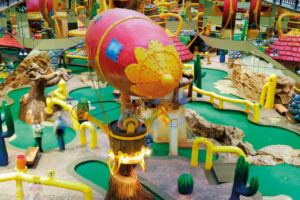InterGame takes a closer look at the benefit of offering indoor attractions.


The FEC and out of home attractions market has become increasingly competitive and many are now looking to create additional attractions to make their location a destination for visitors. Indoor rides, theatres and attractions are, in a lot of ways, the perfect solution, offering a unique player experience.
For John Brennan of Namco Europe, which recently introduced its Deadstorm Pirates theatre-style ride, in some ways indoor rides really do replicate the excitement of outdoor rides. “You only have to see the faces and hear the screams of enjoyment,” he says. But the advantage of indoor rides is the fact that they remain popular whatever the weather – something that is especially useful in parts of the world where the weather can be somewhat unpredictable.
“In Deadstorm Pirates, for example, the player is an active participant and this really sets our rides apart from others on the market,” says Brennan. “An indoor ride such as Deadstorm Pirates creates a spectacle – firstly there is the incredible signage, which has the wow factor. There is also the fact that the game itself is extremely immersive, so the player is involved in the experience rather than just being thrown around. This creates a greater feeling of ownership and encourages repeat play. It is something that Namco has successfully incorporated in many of its other games as well.”
According to World of Rides’ David Robinson, based in the UK, the needs of the non-gaming amusement and leisure industries have now gone full circle and reverted back to focus on attracting the spend of the three to 12-year-old age group and the need for the whole family to be able to share in their play.
World of Rides has concentrated on developing a whole range of pollution-free family rides such as its battery go-karts, quad bikes, bumper cars and bumper boats that can all be ridden by either two children or a parent and child, either indoors or outdoors. Its quad bikes and off-road jeeps can even be used to uplift low-earning or redundant ice rinks due to their special wheels and tyres.
“The key factor in all modern day children’s rides is that they all want interaction,” says Robinson. “Our moving battery ride that can be fully controlled by the child is always very popular when used alongside other interactive amusements and activity games such as our air hockey tables and basketball games, children’s cranes and novelty vendors.
“Every year we see more and more FECs installing battery rides in place of their low earning equipment and operators are seeing their overall takings rise considerably as a result. Many of the UK’s leading operators now operate more than one battery car track within their FECs without any decline in the takings of either one, due to them using different model ranges on each track.”
One of the main needs of the indoor amusement market is flexibility and according to Michal Oczkowski of Budgast, which specialises in interactive experiences such as 4D theatres, roller coasters, rapid rivers and rafts and also developed the first prehistoric 3D oceanarium, we can forget about the days where locations would keep the same attraction on site for 20 or more years.
“The market is changing because people and their tastes are changing,” he tells InterGame. “That is why ay Budgast, we focus on the innovative possibilities available to us by frequently updating our product offering. While indoor locations are limited in some respects by capacity and size, the one advantage, without doubt, is the year-round availability to customers.”
This feature can be read in full in the July 2012 issue of InterGame magazine.

